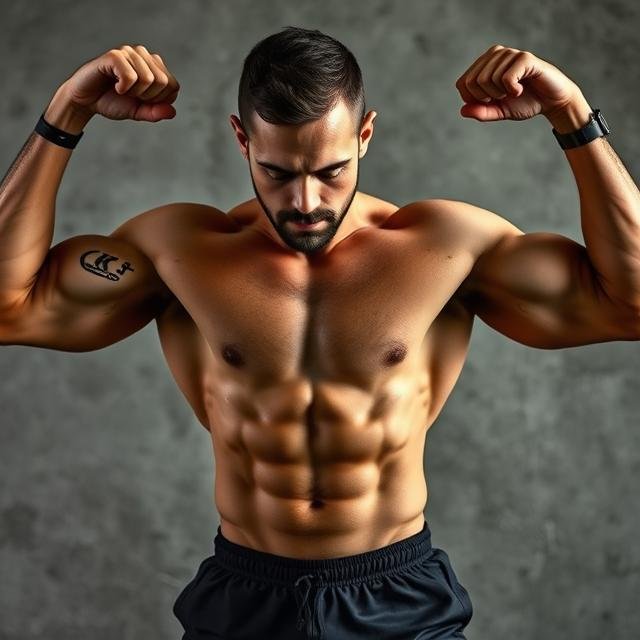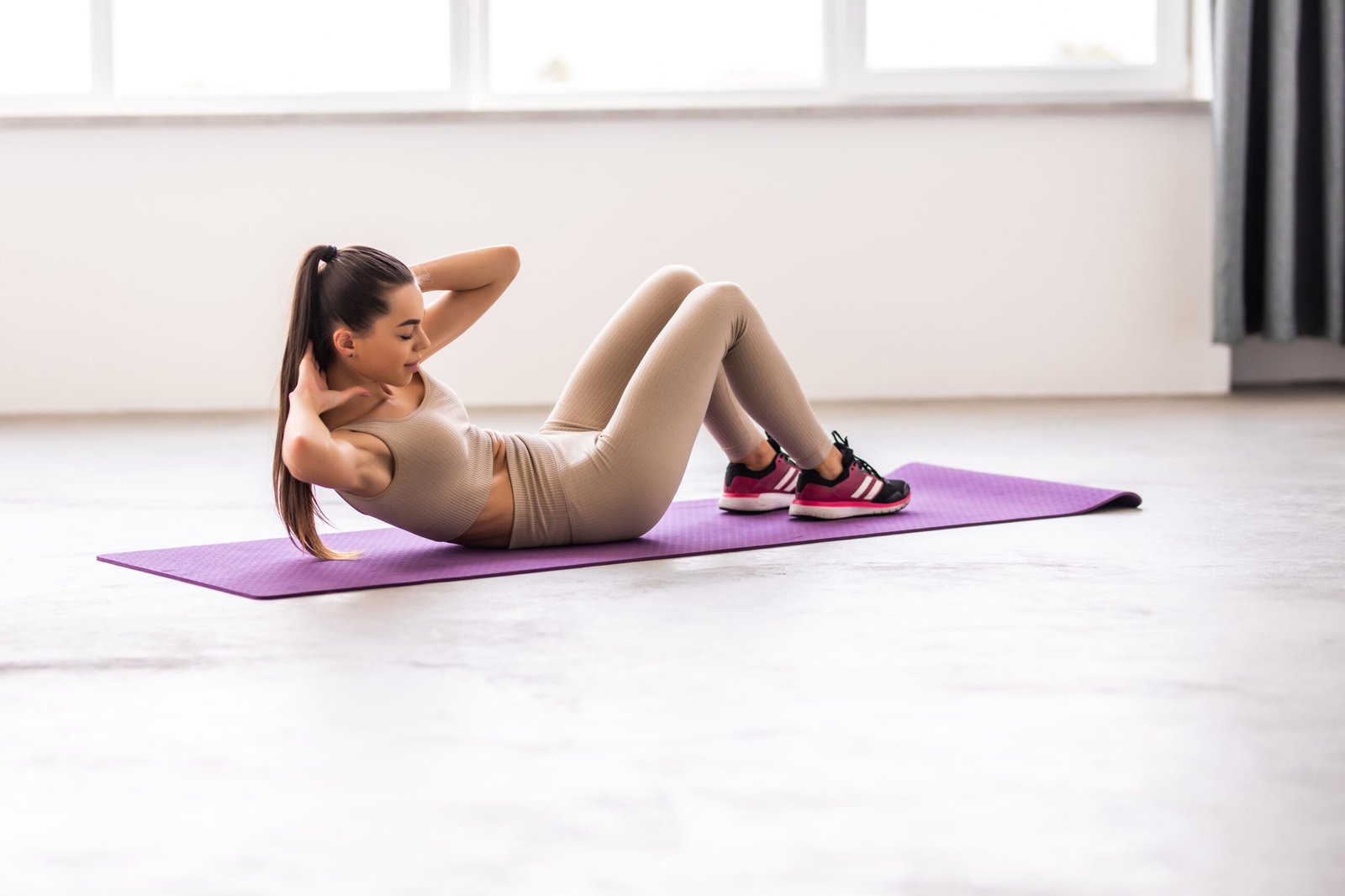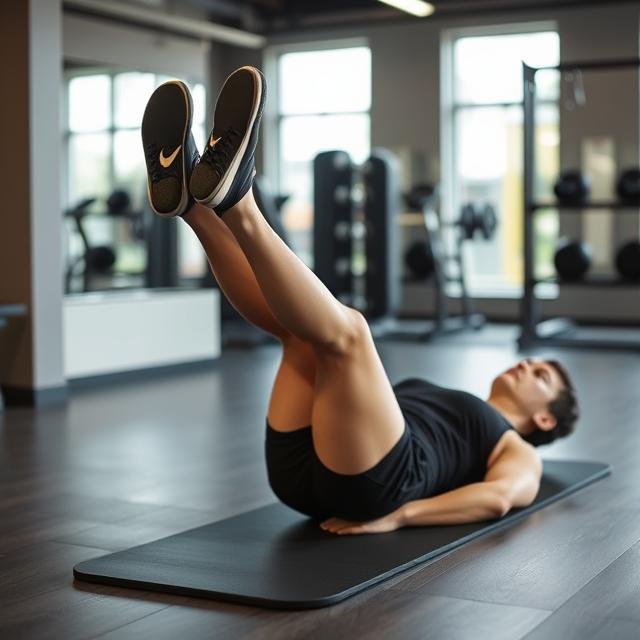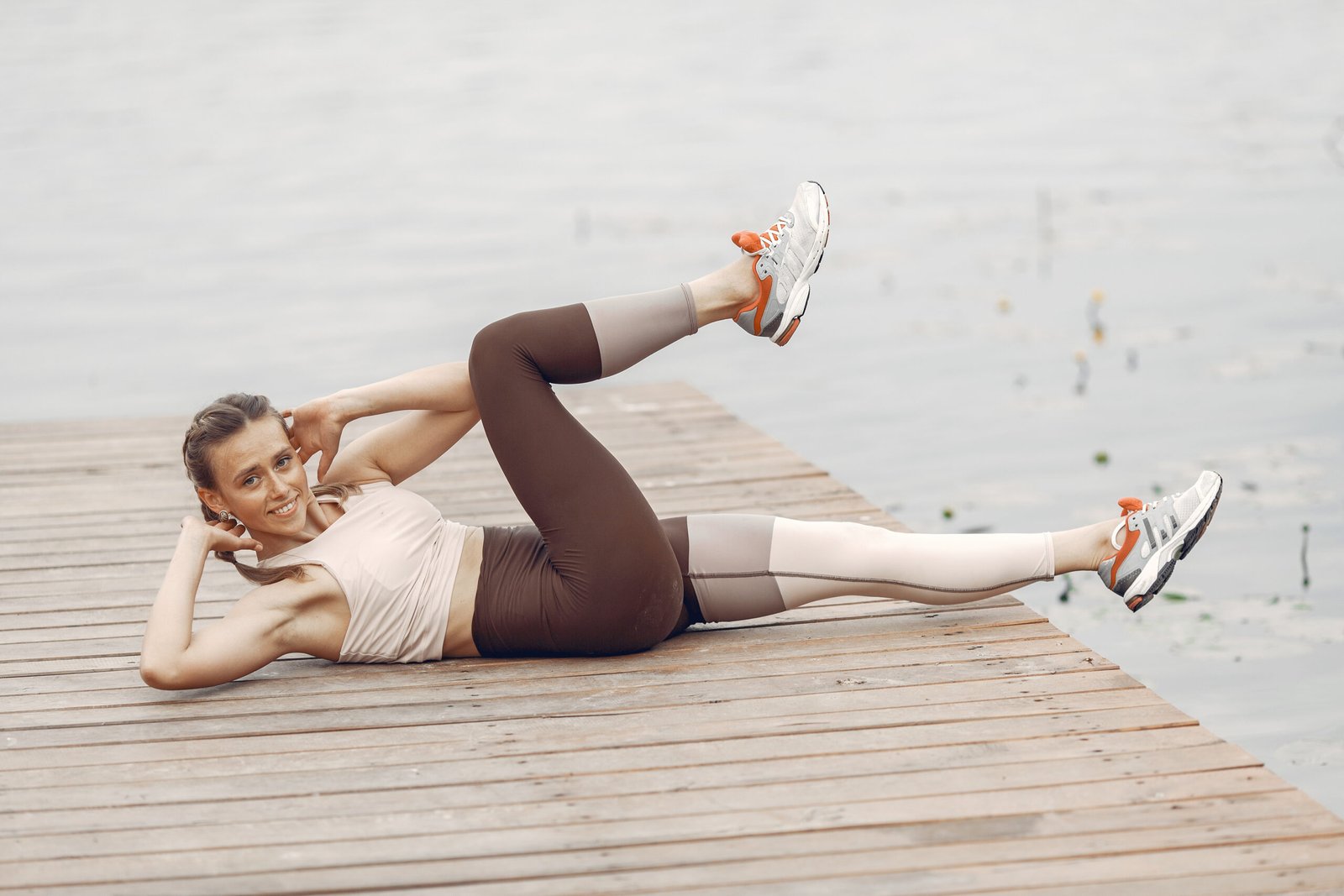
Core Workouts
Core workouts are essential for building strength and stability in the muscles that support your spine and pelvis, including the abdominals, obliques, lower back, and hips. These exercises not only help improve posture and balance but also enhance overall athletic performance and reduce the risk of injury. Core workouts can range from simple bodyweight movements like planks and crunches to more dynamic exercises like mountain climbers and hanging leg raises. Incorporating core training into your routine a few times a week can lead to better control during lifts, more efficient movement patterns, and a stronger, more resilient body overall.

Russian Twists
The Russian twist is a core-strengthening exercise that targets the abdominal muscles, particularly the obliques. Performed by sitting on the floor with knees bent and feet either lifted or resting on the ground, the individual leans back slightly to engage the core and then twists the torso from side to side, often while holding a weight or medicine ball. This rotational movement helps improve balance, stability, and rotational strength, making it a popular addition to many ab-focused workouts. The Russian twist is especially effective for enhancing overall core definition and functional movement, but proper form is essential to prevent strain on the lower back.
Here are some variations of the classic Russian twist that will add variety and challenge to your workout:
1. Basic Russian Twist (Bodyweight)
- Target: Obliques, abs, and hip flexors.
- How to Do It:
- Sit on the floor with your knees bent and feet flat.
- Lean back slightly to engage your core while keeping your back straight.
- Hold your hands together in front of you or place them slightly apart.
- Rotate your torso to one side, then to the other, tapping the floor beside you with your hands as you twist.
- Perform this in a controlled, rhythmic manner.
- Sit on the floor with your knees bent and feet flat.
2. Weighted Russian Twist
- Target: Obliques and abs with added resistance.
- How to Do It:
- Perform the basic Russian twist but hold a weight (such as a dumbbell, medicine ball, or kettlebell) with both hands.
- Rotate your torso from side to side, tapping the weight on the floor beside each hip.
- This adds resistance, making the exercise more challenging.
- Perform the basic Russian twist but hold a weight (such as a dumbbell, medicine ball, or kettlebell) with both hands.
3. Russian Twist with Medicine Ball
- Target: Obliques, core, and shoulders.
- How to Do It:
- Sit on the floor with your knees bent and your feet flat.
- Hold a medicine ball with both hands, keeping your arms extended in front of you.
- Twist your torso to one side while keeping the ball close to your body.
- Engage your core and control the ball as you rotate side to side, tapping the ball lightly on the floor beside you.
- Sit on the floor with your knees bent and your feet flat.
4. Russian Twist with Leg Lift
- Target: Obliques, core, and hip flexors.
- How to Do It:
- Start in the basic Russian twist position with your legs lifted off the floor.
- Engage your core and maintain a slight lean back.
- Rotate your torso side to side while keeping your legs lifted, maintaining balance and stability.
- This variation increases the difficulty by engaging the lower abs and hip flexors as well.
- Start in the basic Russian twist position with your legs lifted off the floor.
5. Medicine Ball Slam Russian Twist
- Target: Obliques, core, shoulders, and arms.
- How to Do It:
- Start in a seated position with your knees bent and feet off the ground, holding a medicine ball.
- Twist your torso to one side and slam the medicine ball down next to you.
- Return the ball to your hands, twist to the opposite side, and slam the ball down.
- This adds a dynamic movement to the twist, increasing power and intensity.
- Start in a seated position with your knees bent and feet off the ground, holding a medicine ball.
6. Russian Twist with Resistance Band
- Target: Obliques and core with resistance.
- How to Do It:
- Secure a resistance band to a sturdy object at chest height and hold the band with both hands.
- Sit on the floor with your knees bent and feet flat.
- Pull the resistance band and rotate your torso from one side to the other, keeping your arms straight and engaging your core.
- The band adds resistance to each twist, making the exercise more challenging.
- Secure a resistance band to a sturdy object at chest height and hold the band with both hands.
7. Stability Ball Russian Twist
- Target: Obliques, core, and balance.
- How to Do It:
- Sit on a stability ball with your feet flat on the floor and knees bent.
- Lean back slightly to engage your core, and place your hands together or hold a weight.
- Twist your torso from side to side, tapping the floor with your hands on each rotation.
- The instability of the ball challenges your core stability and adds difficulty to the movement.
- Sit on a stability ball with your feet flat on the floor and knees bent.
8. Cross-Body Russian Twist
- Target: Obliques, core, and shoulders.
- How to Do It:
- Sit with your knees bent and feet flat on the floor.
- Hold a dumbbell, medicine ball, or kettlebell in one hand.
- Twist your torso to the side, crossing the weight in front of your body to the opposite side.
- Engage your core and control the movement as you twist back and forth, focusing on the obliques.
- Sit with your knees bent and feet flat on the floor.
9. Russian Twist with a Hop
- Target: Obliques, abs, and cardio.
- How to Do It:
- Start in a basic Russian twist position with your feet flat on the floor.
- Instead of just twisting your torso, add a small hop in between each twist, alternating sides.
- This variation adds a cardiovascular component and increases the intensity of the exercise.
- Start in a basic Russian twist position with your feet flat on the floor.
10. Side Plank Russian Twist
- Target: Obliques, shoulders, and core.
- How to Do It:
- Start in a side plank position with your forearm on the floor and your body in a straight line.
- Hold a weight or your hands together in front of your body.
- Twist your torso towards the ground and then return to the side plank position, alternating sides.
- This combines the side plank’s core stability challenge with the rotational movement of the Russian twist.
- Start in a side plank position with your forearm on the floor and your body in a straight line.
11. Decline Russian Twist
- Target: Upper and lower abdominals, obliques.
- How to Do It:
- Use a decline bench to perform the twist. Place your feet securely at the top of the bench, lying back with your torso at a slight incline.
- Perform a standard Russian twist, rotating your torso side to side.
- The decline angle increases the intensity of the exercise, challenging the core further.
- Use a decline bench to perform the twist. Place your feet securely at the top of the bench, lying back with your torso at a slight incline.
By incorporating these different Russian twist variations into your routine, you can keep your workouts fresh and progressively increase the challenge for your core

Leg Raises
Leg raises are a highly effective abdominal exercise that primarily targets the lower abs, while also engaging the hip flexors and stabilizing muscles. Performed by lying flat on your back with legs extended, you lift your legs toward the ceiling while keeping them straight, then slowly lower them back down without letting them touch the floor. This controlled motion challenges the core and helps build strength and definition in the lower abdominal region. Leg raises can be modified for different fitness levels, with variations like hanging leg raises or adding ankle weights for increased intensity. Maintaining proper form is crucial to maximize results and avoid lower back strain.
Here are some of the most effective types of leg raises:
1. Basic Leg Raise
- Target: Lower abs, hip flexors, and core.
- How to Do It:
- Lie flat on your back with your legs extended and your arms at your sides or under your hips for support.
- Slowly lift your legs towards the ceiling, keeping them straight.
- Lower them back down slowly without letting your feet touch the floor.
- Engage your core throughout the movement to keep your lower back pressed into the ground.
- Lie flat on your back with your legs extended and your arms at your sides or under your hips for support.
2. Hanging Leg Raise
- Target: Lower abs, hip flexors, and forearms.
- How to Do It:
- Hang from a pull-up or dip bar with your arms extended and legs straight.
- Slowly raise your legs up to around a 90-degree angle or higher.
- Lower your legs slowly back down.
- Avoid swinging your body; focus on using your core muscles to lift your legs.
- Hang from a pull-up or dip bar with your arms extended and legs straight.
3. Reverse Leg Raise
- Target: Lower abs and core.
- How to Do It:
- Lie flat on your back with your arms at your sides.
- Bend your knees slightly and raise your legs so your feet are off the floor.
- Instead of lifting your legs straight up, focus on curling your pelvis upward and using your lower abs to raise your legs.
- Lower your legs slowly, maintaining control of the movement.
- Lie flat on your back with your arms at your sides.
4. Side Leg Raise
- Target: Hip abductors, obliques, and lower abs.
- How to Do It:
- Lie on your side with your legs stacked on top of each other and your arms extended for support.
- Keep your body in a straight line and lift your top leg toward the ceiling.
- Lower it slowly, maintaining control, and repeat.
- Engage your obliques as you lift and lower your leg.
- Lie on your side with your legs stacked on top of each other and your arms extended for support.
5. Leg Raise with Pulse
- Target: Lower abs, hip flexors, and core.
- How to Do It:
- Perform a regular leg raise (either flat on your back or hanging).
- Once your legs are raised at a 90-degree angle, pulse your legs up and down slightly, increasing the time your core is under tension.
- After several pulses, slowly lower your legs back down.
- Perform a regular leg raise (either flat on your back or hanging).
6. Weighted Leg Raise
- Target: Lower abs, hip flexors, and core (with added resistance).
- How to Do It:
- Perform a basic leg raise with an ankle weight or hold a dumbbell between your feet.
- Lift your legs as you would in the basic leg raise, but with added resistance.
- Lower your legs slowly, maintaining control.
- The extra weight will increase the difficulty of the movement, leading to more muscle engagement.
- Perform a basic leg raise with an ankle weight or hold a dumbbell between your feet.
7. Decline Leg Raise
- Target: Lower abs, core, and hip flexors.
- How to Do It:
- Lie on a decline bench with your legs extended and your arms at your sides.
- Keep your legs straight and lift them towards the ceiling.
- Lower your legs back slowly without letting your feet touch the bench.
- The incline adds an extra challenge to the movement, making your core work harder.
- Lie on a decline bench with your legs extended and your arms at your sides.
8. Bicycle Leg Raise
- Target: Lower abs, hip flexors, and obliques.
- How to Do It:
- Lie on your back with your hands behind your head or at your sides.
- Lift your legs and alternate bending them as if pedaling a bicycle.
- As one leg bends, twist your torso slightly to bring your opposite elbow toward the bent knee.
- Extend the leg back out and alternate sides, keeping a steady rhythm.
- Lie on your back with your hands behind your head or at your sides.
9. V-Up Leg Raise
- Target: Lower abs, upper abs, and hip flexors.
- How to Do It:
- Lie flat on your back with your legs extended and arms overhead.
- Simultaneously raise your legs and upper body, bringing your hands toward your feet.
- As you reach your feet, try to form a “V” shape with your body.
- Slowly lower your upper body and legs back down with control.
- Lie flat on your back with your legs extended and arms overhead.
10. Scissor Leg Raise
- Target: Lower abs, hip flexors, and core stability.
- How to Do It:
- Lie flat on your back with your arms at your sides.
- Raise both legs off the floor, keeping them straight.
- Cross your legs back and forth in a scissor-like motion.
- Engage your abs to control the movement and keep your lower back pressed into the floor.
- Lie flat on your back with your arms at your sides.
11. Toe Touch Leg Raise
- Target: Lower abs and upper abs.
- How to Do It:
- Lie flat on your back with your arms extended towards your feet.
- Lift your legs towards the ceiling and try to touch your toes with your hands.
- Lower your legs back down slowly without letting them touch the ground.
- Engage your abs throughout the movement.
- Lie flat on your back with your arms extended towards your feet.
12. Butterfly Leg Raise
- Target: Lower abs, hip flexors, and core.
- How to Do It:
- Lie on your back and bring the soles of your feet together, letting your knees fall outward like a butterfly.
- Keeping your feet together, raise your legs off the floor while engaging your core.
- Lower your legs slowly back down, maintaining control throughout the movement.
- Lie on your back and bring the soles of your feet together, letting your knees fall outward like a butterfly.
13. Alternating Leg Raise
- Target: Lower abs, core, and hip flexors.
- How to Do It:
- Lie on your back with your legs extended and arms at your sides.
- Slowly raise one leg toward the ceiling while keeping the other leg on the ground.
- Lower the raised leg and alternate, ensuring you keep the movement slow and controlled.
- This variation works each leg independently, helping improve core stability.
- Lie on your back with your legs extended and arms at your sides.
Incorporating different types of leg raises into your workout routine will not only improve your lower abs and core strength but also add variety and challenge. Whether you’re a beginner or advanced, you can adjust the difficulty by changing the variation or adding weights to increase intensity.

Bicycle Crunch
The bicycle crunch is a dynamic abdominal exercise that targets the entire core, with a strong emphasis on the obliques and rectus abdominis. To perform it, lie on your back with your hands behind your head, lift your shoulders off the ground, and bring your knees toward your chest. Then, alternate touching each elbow to the opposite knee in a pedaling motion, as if riding a bicycle. This movement engages both the upper and lower abs while promoting rotational strength and coordination. The bicycle crunch is known for its efficiency in activating more abdominal muscles compared to many other core exercises, making it a staple in effective ab workouts. Proper form and a controlled pace are key to maximizing benefits and minimizing the risk of neck or lower back strain.
Here are some of the most common and effective types of bicycle crunches:
1. Traditional Bicycle Crunch
- Target: Rectus abdominis, obliques, and hip flexors.
- How to Do It:
- Lie flat on your back with your knees bent and hands placed behind your head.
- Lift your head, neck, and shoulders off the floor and bring your knees toward your chest.
- As you extend your left leg out, twist your torso to bring your right elbow toward your left knee.
- Extend your right leg while bringing your left elbow toward your right knee.
- Continue alternating sides in a pedaling motion.
- Lie flat on your back with your knees bent and hands placed behind your head.
2. Slow Bicycle Crunch
- Target: Core, obliques, and rectus abdominis (with a focus on control).
- How to Do It:
- Follow the traditional bicycle crunch movement but slow down the speed to focus on controlled muscle engagement.
- Hold each crunch for 2-3 seconds to increase the time under tension and make the exercise more challenging.
- This variation increases the intensity by focusing on form and controlled movement.
- Follow the traditional bicycle crunch movement but slow down the speed to focus on controlled muscle engagement.
3. Weighted Bicycle Crunch
- Target: Obliques, rectus abdominis, and hip flexors (with added resistance).
- How to Do It:
- Perform the traditional bicycle crunch while holding a weight, such as a medicine ball or dumbbell, in both hands.
- Keep the weight close to your chest as you twist and crunch, making the movement more challenging.
- The added weight will increase resistance and help tone your muscles faster.
- Perform the traditional bicycle crunch while holding a weight, such as a medicine ball or dumbbell, in both hands.
4. Elevated Bicycle Crunch
- Target: Obliques, rectus abdominis, and lower abs.
- How to Do It:
- Perform the traditional bicycle crunch but elevate your legs slightly off the floor (around 6–12 inches).
- The elevated position increases the engagement of the lower abdominal muscles as you twist and alternate your legs.
- The higher your legs are, the harder the exercise becomes, challenging your core even more.
- Perform the traditional bicycle crunch but elevate your legs slightly off the floor (around 6–12 inches).
5. Cross-Body Bicycle Crunch
- Target: Obliques and rectus abdominis.
- How to Do It:
- Start in the traditional bicycle crunch position.
- Instead of twisting your torso to bring your opposite elbow to your knee, focus on crossing your torso more deeply. Try bringing your elbow toward the opposite knee (right elbow to left knee and vice versa) in a more exaggerated movement.
- This variation targets the obliques more intensely.
- Start in the traditional bicycle crunch position.
6. Reverse Bicycle Crunch
- Target: Lower abs, rectus abdominis, and hip flexors.
- How to Do It:
- Lie flat on your back with your arms at your sides and legs extended.
- Bring your knees toward your chest and start making a “pedaling” motion with your legs.
- Instead of twisting your torso like a traditional bicycle crunch, this version focuses on engaging your lower abs and hip flexors by mimicking a reverse bicycle pedaling motion.
- Keep your head and shoulders on the ground to keep the focus on your lower body.
- Lie flat on your back with your arms at your sides and legs extended.
7. Bicycle Crunch with Leg Extension
- Target: Obliques, rectus abdominis, and hip flexors.
- How to Do It:
- Begin in the traditional bicycle crunch position.
- Instead of just bringing one knee toward your chest at a time, extend the opposite leg completely straight as you twist your torso.
- This movement combines the bicycle crunch with a leg extension, adding an extra challenge to your abs and engaging your hip flexors.
- Begin in the traditional bicycle crunch position.
8. Standing Bicycle Crunch
- Target: Obliques, rectus abdominis, and legs (with added full-body engagement).
- How to Do It:
- Stand with your feet hip-width apart and hands placed behind your head.
- Bring your left knee toward your right elbow while twisting your torso to the left.
- Alternate sides, bringing your right knee toward your left elbow.
- This variation works your core while engaging your legs and stabilizer muscles, making it a more dynamic, full-body exercise.
- Stand with your feet hip-width apart and hands placed behind your head.
9. Stability Ball Bicycle Crunch
- Target: Core, rectus abdominis, and obliques (with a focus on stability).
- How to Do It:
- Sit on a stability ball and walk your feet forward so that your back is supported by the ball.
- Place your hands behind your head and lift your head, neck, and shoulders off the ball.
- Perform the bicycle crunch by alternating knee drives toward your chest, twisting your torso to touch your opposite elbow to the knee.
- The instability of the ball challenges your core to maintain balance throughout the movement.
- Sit on a stability ball and walk your feet forward so that your back is supported by the ball.
10. Medicine Ball Bicycle Crunch
- Target: Core, obliques, rectus abdominis, and shoulders (with added resistance).
- How to Do It:
- Perform the bicycle crunch while holding a medicine ball with both hands.
- As you twist to bring one elbow toward the opposite knee, extend the medicine ball in the same direction, maintaining tension.
- The added weight of the ball increases the challenge to your abs and core.
- Perform the bicycle crunch while holding a medicine ball with both hands.
Benefits of Bicycle Crunch Variations
- Core Activation: All variations engage the core muscles, including the lower and upper abs, obliques, and hip flexors.
- Increased Intensity: Modifying the speed, adding resistance, or changing the movement pattern makes the exercise more challenging, which helps in strengthening the core faster.
- Full-Body Engagement: Some variations, such as the standing bicycle crunch, also engage the legs and improve balance, turning the exercise into a full-body movement.
- Flexibility and Coordination: The twisting motion of bicycle crunches helps improve flexibility and coordination in the torso and hips.
Tips for Bicycle Crunches
- Form: Keep your lower back pressed against the floor to avoid strain on your back.
- Controlled Movement: Perform the movement slowly to engage your muscles fully and prevent momentum from doing the work.
- Breathing: Exhale as you twist your torso and inhale as you return to the starting position.
- Neck Position: Keep your neck relaxed and avoid pulling on it with your hands. Your hands should lightly support your head without exerting force.
By incorporating these bicycle crunch variations into your routine, you can target your core from different angles and progressively challenge your abdominal muscles, improving overall strength and endurance.